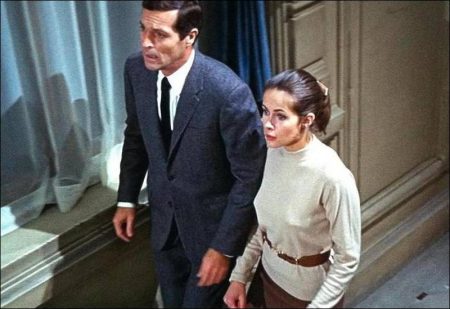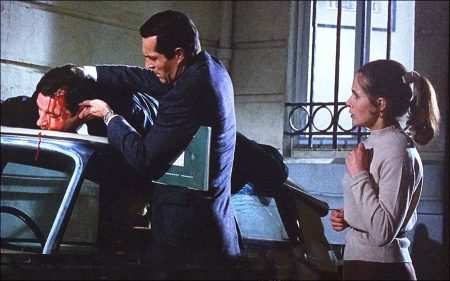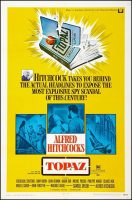Taglines: What is TOPAZ? Is TOPAZ a person? A code name? A mystery?
Topaz movie storyline. A highly ranked Russian official, Boris Kusenov, his wife and daughter defect to America. Hoped to be a boon for their efforts battling the Cold War with Russia, the Americans soon find out that they have more to deal with than first thought, with Kusenov being less than cooperative, especially in regards to anything to do with a known leak in the French government, codenamed “Topaz”, which has seen top secret files leaked to those in Moscow.
On discovering an agreement between the Russians and Cubans, agent Nordstrom enlists the aid of his friend, and French Intelligence Agent, André Devereaux, who, at this time, is accompanying his daughter Michele on her honeymoon with journalist Francois Picard. André accepts, but his wife Nicole is worried for him. After managing to get ahold of some seriously damning papers from the visiting Cuban official Rico Parra, sneakily of course, a concerned Devereaux jets off to Cuba and catches up with his mistress Juanita de Cordoba, who is now secretly involved with a local underground movement while also being involved in another way with Parra.
He finds out and kills Juanita. Ever the jet setter, Devereaux is now off home to Paris to get to the bottom of this whole leak problem. Michele wants to reconcile her parents. Nicole cheats André after his Cuban affair with the leader of the spy-ring “Topaz”, Jacques Granville. Francois goes on, to find out, who is “Topaz”, and he interrogates N.A.T.O. official Henri Jarre. A short time later, Michèle finds the murdered Jarré, and Francois is missing.
Topaz is a 1969 American espionage thriller film directed by Alfred Hitchcock. Based on the 1967 Cold War novel Topaz by Leon Uris, the film is about a French intelligence agent who becomes entangled in the Cold War politics of before the 1962 Cuban Missile Crisis and then the breakup of an international Soviet spy ring in France.
The story is loosely based on the 1962 Sapphire Affair, which involved the head of France’s SDECE in the United States, the spy Philippe Thyraud de Vosjoli, a friend of Uris, who played an important role in “helping the U.S. discover the presence of Russian offensive missiles in Cuba.” The film stars Frederick Stafford, Dany Robin, John Vernon, Karin Dor, Michel Piccoli, Philippe Noiret, Claude Jade, Michel Subor, Tina Hedström, Sonja Kolthoff and Roscoe Lee Browne.
Like his previous films Rope and The Trouble with Harry, Hitchcock intended the film to be an experiment for whether colours, predominantly red, yellow and white, could be used to reveal and to influence the plot. He later admitted that it did not work out. Prior to Hitchcock’s decision to hire Maurice Jarre to compose the score, other composers who were interested in offering their services included Michel Legrand, Richard Rodney Bennett, and Ravi Shankar.
Topaz: Alfred Hitchcock at his best
It’s perfectly apparent from its opening sequence that no one except Alfred Hitchcock, the wise, round, supremely confident storyteller, is in charge of “Topaz,” the film that opened yesterday at the Cinerama Theater. “Topaz,” the code name for a Russian spy ring within the French Government, is the film adaptation of the Leon Uris novel, which itself was based on a real-life espionage scandal that kept both sides of the Atlantic busy in 1962.
Hitchcock sets his scene in a first act that dramatizes the defection of a high Soviet intelligence officer to C.I.A. officials in Copenhagen. The sequence, which lasts approximately 10 minutes and uses only a minimum of dialogue, is virtuoso Hitchcock, beginning with a dazzling, single-take pan shot outside the Soviet Embassy, then detailing the flight, pursuit through, among other things, a ceramics factory and the final safe arrival of the irritable Soviet official and his family aboard an American plane headed for Wiesbaden. The Russian’s only comment to the proud C.I.A. man: “We would have done it better.”
“Topaz” is not a conventional Hitchcock film. It’s rather too leisurely and the machinations of the plot rather too convoluted to be easily summed up in anything except a very loose sentence. Being pressed, I’d say that it’s about espionage as a kind of game, set in Washington, Havana and Paris at the time of the Cuban missile crisis, involving a number of dedicated people in acts of courage, sacrifice and death, after which the survivors find themselves pretty much where they started, except that they are older, tired and a little less capable of being happy.
“Topaz” is, however, quite pure Hitchcock, a movie of beautifully composed sequences, full of surface tensions, ironies, absurdities (some hungry seagulls blow the cover of two Allied agents), as well as of odd references to things such as Michaelangelo’s “Pieta,” only it’s not a Mother holding her dead Son, but a middle-aged Cuban wife holding her dead husband, after they’ve been tortured in a Castro prison.
Hitchcock, who can barely tolerate actors, has been especially self-indulgent in the casting of “Topaz.” The film has no one on the order of James Stewart or Cary Grant on which to depend, although it does use some fine character actors (Michel Piccoli, Phillipe Noiret) in small roles. Most of its performers are, if not entirely unknown, so completely subordinate to their roles that they seem, perhaps unfairly, quite forgettable.
John Stafford, who plays a Washington-based French intelligence man (and is more or less the lead), and John Forsythe, his counterpart in the Central Intelligence Agency, have all the panache of well-tailored salesmen of electrical appliances. Dany Robin, cast as Stafford’s worried wife, and Claude Jade, who was so lovely in Truffaut’s “Stolen Kisses,” and who here plays Stafford’s worried daughter, frown quite a lot.
The people one remembers are those who are employed for the effect of their looks (John Vernon as a bearded Castro aide with brilliant blue eyes, Carlos Rivas as his bodyguard, a Cuban with remarkably red hair), or who are bequeathed vivid images by the narrative (Karin Dor as a beautiful anti-Castro Cuban who is shot for her efforts and collapses onto a marble floor, her body framed by the brilliant purple of her dress).
The star of “Topaz” is Hitchcock, who, except for his brief, signature appearance, remains just off-screen, manipulating our emotions as well as our memories of so many other Hitchcock films, including “Foreign Correspondent,” “Saboteur” and “Torn Curtain,” all inferior to “Topaz.” This is a movie of superb sequences that lead from a magnificent Virginia mansion to the Hotel Theresa in Harlem, from an extraordinarily well-stocked Cuban hacienda to a small, claustrophobic, upstairs dining room in a Paris restaurant. Even architecture is important.
It’s also a movie of classic Hitchcock effects. Exposition may be gotten across by being presented either as gossip or as incidental, postcoital small talk. Conversations are often seen — but not heard — through glass doors. A Cuban government minister, staying at the Theresa, finds a misplaced state document being used as a hamburger napkin.
The film is so free of contemporary cinematic cliches, so reassuring in its choice of familiar espionage gadgetry (remote control cameras, Geiger counters), that it tends to look extremely conservative, politically. “Topaz,” however, is really above such things. It uses politics the way Hitchcock uses actors — for its own ends, without making any real commitments to it. “Topaz” is not only most entertaining. It is, like so many Hitchcock films, a cautionary fable by one of the most moral cynics of our time.
Topaz (1969)
Directed by: Alfred Hitchcock
Starring: Frederick Stafford, Dany Robin, John Vernon, Karin Dor, Michel Piccoli, Philippe Noiret, Claude Jade, Michel Subor, Tina Hedström, Sonja Kolthoff, Roscoe Lee Browne
Screenplay by: Samuel A. Taylor
Production Design by: Henry Bumstead
Cinematography by: Jack Hildyard
Film Editing by: William H. Ziegler
Costume Design by: Edith Head
Set Decoration by: John P. Austin
Music by: Maurice Jarre
MPAA Rating: None.
Distributed by: Universal Pictures
Release Date: December 19, 1969
Views: 299





